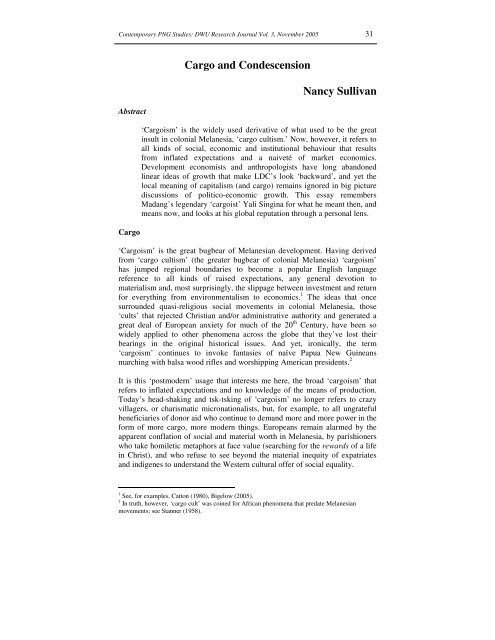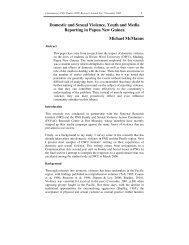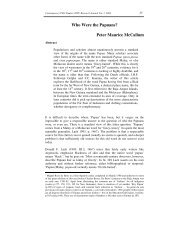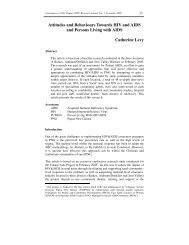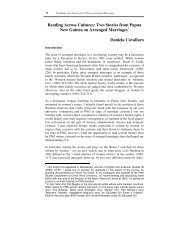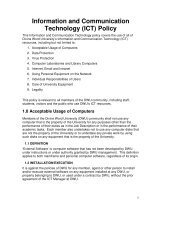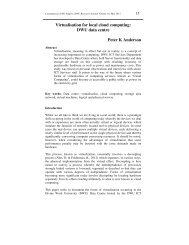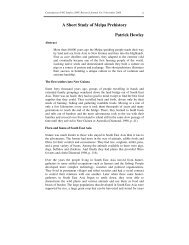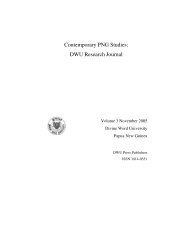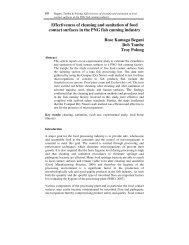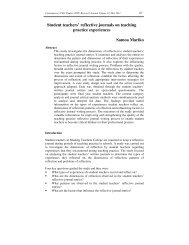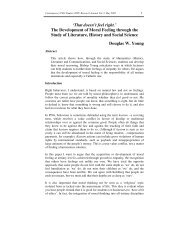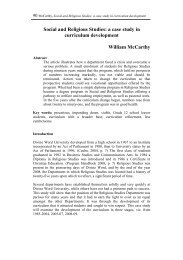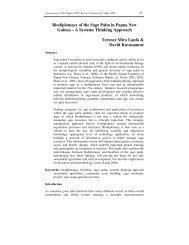Cargo and Condescension Nancy Sullivan - Divine Word University
Cargo and Condescension Nancy Sullivan - Divine Word University
Cargo and Condescension Nancy Sullivan - Divine Word University
You also want an ePaper? Increase the reach of your titles
YUMPU automatically turns print PDFs into web optimized ePapers that Google loves.
Contemporary PNG Studies: DWU Research Journal Vol. 3, November 2005 31<br />
Abstract<br />
<strong>Cargo</strong><br />
<strong>Cargo</strong> <strong>and</strong> <strong>Condescension</strong><br />
<strong>Nancy</strong> <strong>Sullivan</strong><br />
‘<strong>Cargo</strong>ism’ is the widely used derivative of what used to be the great<br />
insult in colonial Melanesia, ‘cargo cultism.’ Now, however, it refers to<br />
all kinds of social, economic <strong>and</strong> institutional behaviour that results<br />
from inflated expectations <strong>and</strong> a naiveté of market economics.<br />
Development economists <strong>and</strong> anthropologists have long ab<strong>and</strong>oned<br />
linear ideas of growth that make LDC’s look ‘backward’, <strong>and</strong> yet the<br />
local meaning of capitalism (<strong>and</strong> cargo) remains ignored in big picture<br />
discussions of politico-economic growth. This essay remembers<br />
Madang’s legendary ‘cargoist’ Yali Singina for what he meant then, <strong>and</strong><br />
means now, <strong>and</strong> looks at his global reputation through a personal lens.<br />
‘<strong>Cargo</strong>ism’ is the great bugbear of Melanesian development. Having derived<br />
from ‘cargo cultism’ (the greater bugbear of colonial Melanesia) ‘cargoism’<br />
has jumped regional boundaries to become a popular English language<br />
reference to all kinds of raised expectations, any general devotion to<br />
materialism <strong>and</strong>, most surprisingly, the slippage between investment <strong>and</strong> return<br />
for everything from environmentalism to economics. 1 The ideas that once<br />
surrounded quasi-religious social movements in colonial Melanesia, those<br />
‘cults’ that rejected Christian <strong>and</strong>/or administrative authority <strong>and</strong> generated a<br />
great deal of European anxiety for much of the 20 th Century, have been so<br />
widely applied to other phenomena across the globe that they’ve lost their<br />
bearings in the original historical issues. And yet, ironically, the term<br />
‘cargoism’ continues to invoke fantasies of naïve Papua New Guineans<br />
marching with balsa wood rifles <strong>and</strong> worshipping American presidents. 2<br />
It is this ‘postmodern’ usage that interests me here, the broad ‘cargoism’ that<br />
refers to inflated expectations <strong>and</strong> no knowledge of the means of production.<br />
Today’s head-shaking <strong>and</strong> tsk-tsking of ‘cargoism’ no longer refers to crazy<br />
villagers, or charismatic micronationalists, but, for example, to all ungrateful<br />
beneficiaries of donor aid who continue to dem<strong>and</strong> more <strong>and</strong> more power in the<br />
form of more cargo, more modern things. Europeans remain alarmed by the<br />
apparent conflation of social <strong>and</strong> material worth in Melanesia, by parishioners<br />
who take homiletic metaphors at face value (searching for the rewards of a life<br />
in Christ), <strong>and</strong> who refuse to see beyond the material inequity of expatriates<br />
<strong>and</strong> indigenes to underst<strong>and</strong> the Western cultural offer of social equality.<br />
1 See, for examples, Catton (1980), Bigelow (2005).<br />
2 In truth, however, ‘cargo cult’ was coined for African phenomena that predate Melanesian<br />
movements; see Stanner (1958).
32 <strong>Nancy</strong> <strong>Sullivan</strong>, <strong>Cargo</strong> <strong>and</strong> <strong>Condescension</strong><br />
Meanwhile, Papua New Guineans continue to dem<strong>and</strong> greater control over<br />
their politico-economic destiny, demurring in the face of generous international<br />
assistance because they have been frisked at the airport, or because Non-<br />
Government Organizations (NGOs) refuse to acknowledge traditional<br />
ceremonial calendars. Don’t these people know what they’re risking Can’t<br />
they weight the significance of the offer being made Resistance to the<br />
hegemony of monopoly capital is absolutely delusional, it is cargoist. And yet<br />
development economics has been informed by anthropology for the past sixty<br />
years, insisting that monetary values be seen as embedded in local cultural<br />
contexts. 3<br />
Anthropologists have increasingly come to regard the original phenomena of<br />
‘cargo cults’ as fabrications of a European discourse anyway. That is, they<br />
acknowledge their existence, but say they only became a special social <strong>and</strong><br />
metaphysical category through the writing of colonial administrators,<br />
missionaries, academics, journalists <strong>and</strong> satirists, all of whom had their own<br />
reasons for making these behaviours appear more bizarre than other social or<br />
political movements. A hard separation between these ‘cults’ <strong>and</strong> the<br />
micronationalist movements that led to <strong>and</strong> precipitated PNG’s Independence<br />
has never been firmly drawn, <strong>and</strong> some have even argued that the more recent<br />
waves of religious cultism have themselves been modelled after sensational<br />
media reports. 4<br />
‘<strong>Cargo</strong> cults’ have occurred around Melanesia for more than 100 years, but<br />
they really gained momentum in PNG following the cataclysmic events of<br />
WWII. Splintered from church <strong>and</strong>/or political action groups, these groups<br />
rejected the slow <strong>and</strong> sometimes fruitless roads to development proposed by<br />
either church or the state, <strong>and</strong> turned to traditional powers to open the road to<br />
political <strong>and</strong> economic progress. Almost always led by a charismatic man or<br />
woman, these ‘new orders’ or ‘new societies’ have always expressed dashed<br />
hopes in the imposed administrations <strong>and</strong> renewed hope in the ways of the<br />
ancestors, even as those ways are almost always adapted to the modern project<br />
(see, e.g. Gesch 1985, 1990). These are revivalist programs as protest<br />
movements, <strong>and</strong> they continue to recur in places around PNG that have not<br />
been touched by government or church-sponsored development.<br />
Some of the post-war movements quickly evolved into self-reliance <strong>and</strong> small<br />
business groups; others grew into micronationalist movements. Nowadays,<br />
simply to apply the term ‘cargo cult’ to some of these is to impute irrationality<br />
to what were actually very successful development strategies—such as Paliau’s<br />
3 See, for examples, Karl Polyani (1944), Cyril Belshaw (1956), <strong>and</strong> of course Amartya Sen<br />
(1997), Hern<strong>and</strong>o de Soto (2000) <strong>and</strong> Jeffrey Sachs (2005). Polanyi first argued that economic<br />
theory cannot be used to analyze nonwestern economies, <strong>and</strong> that the very term ‘economy’ has two<br />
meanings, the formal <strong>and</strong> the substantive, which only coincide in the modern market economy.<br />
This is related to Max Weber’s distinctions between ‘economic action’ <strong>and</strong> ‘rational economic<br />
action,’ a distinction that incidentally underpins Peter Worsley’s analysis of Melanesian cargo<br />
cults (Worsley 1968).<br />
4 For examples, Errington (1974); Hermann (1997); Lindstrom (1993a, 1995); <strong>and</strong> Schieffelin<br />
(1981).
Contemporary PNG Studies: DWU Research Journal Vol. 3, November 2005 33<br />
Win Nasin Movement, Papua Besena, Kabisawali, Purari Action Group,<br />
Mataungan Association, <strong>and</strong> others. Indeed, many leaders of these movements<br />
have gone on to successful public service careers, <strong>and</strong> even—in the case of<br />
Paliau Moloat <strong>and</strong> Josephine Abaijah—been knighted for their contributions to<br />
the nation.<br />
<strong>Condescension</strong><br />
It has always been the religious organizations, those wrapped in quasi-Christian<br />
idioms granting gr<strong>and</strong> supernatural authority to their leaders, which have<br />
stirred fear <strong>and</strong> prurient interest in observers. These include the ‘cults’ that<br />
have inspired lurid tales of fertility orgies, human sacrifice, <strong>and</strong> avowed<br />
Satanism. 5 Missionaries tend to talk about cargoism as an epistemological<br />
confusion, stemming from the inability to normalize rapid social upheaval<br />
brought on by the cash economy, a short-circuit so to speak of the social<br />
‘evolutionary’ process. Never mind that the cash economy has always itself<br />
been part of the Mission, there seems to be a basic inability on the part of<br />
Melanesians to grasp a distinction between homiletic speech <strong>and</strong> a monopoly<br />
capital value system. Missionaries speak from the pulpit of the rewards of a life<br />
in Christ, <strong>and</strong> His bounteous good will, but cannot seem to impress upon their<br />
flock that these are just metaphors. From the web page of one PNG missionary,<br />
for example, we learn that:<br />
<strong>Cargo</strong>ism has come to mean any tribal preoccupation with the mystery<br />
of foreigner's gadgets <strong>and</strong> treasures. <strong>Cargo</strong>ism is the natural outworking<br />
of their world-view assumptions as they try to make sense of the<br />
traumatic upheaval that foreign contact has caused. Thus cargo cults<br />
have emerged to somehow explain their wild experiences with<br />
5 Such ‘cults’ have become inextricably linked to sorcery, traditional fears of female pollution <strong>and</strong><br />
the new threats posed by HIV infection. See, for example, The Sydney Morning Herald, September<br />
2, 2004: Tortures linked to AIDS 'witchcraft', By Craig Skehan. ‘An Australian researcher has<br />
linked Papua New Guinea's burgeoning HIV/AIDS epidemic to the torture <strong>and</strong> murder of women<br />
accused of witchcraft. It was revealed yesterday that one woman died after having her uterus ripped<br />
out with a steel hook <strong>and</strong> others were held down <strong>and</strong> burned with hot metal. In one of the worst<br />
cases, witnesses say women were publicly tortured over almost two weeks to extract confessions<br />
they had killed people using sorcery. Nicole Haley, who recently returned from the remote,<br />
poverty-stricken Lake Kopiago area of the rugged Southern Highl<strong>and</strong>s, interviewed victims <strong>and</strong><br />
perpetrators. Since December, there had been four public vigilante-style ‘trials' of accused witches<br />
involving prolonged torture, she said. However, there are no police stationed in the area to<br />
investigate <strong>and</strong> local elders who objected to the treatment of the women were threatened with<br />
firearms by young men, some high on marijuana. Dr Haley - a postgraduate research fellow at the<br />
Australian National <strong>University</strong> - has lived, studied <strong>and</strong> worked among the Duna people of Lake<br />
Kopiago for extended periods since 1994….At Lake Kopiago, an old man has admitted to<br />
beginning the first of what has become a spate of witchhunts by naming women he said he saw in<br />
dreams using sorcery to make people ill. A tragedy unfolded as six women - aged from their early<br />
20s to early 50s - were held <strong>and</strong> tortured over 13 days. ‘They were beaten, stabbed, cut with bush<br />
knives, burnt with reinforcing iron <strong>and</strong> crowbars,’ Dr Haley said. ‘Two of the women were<br />
sexually assaulted <strong>and</strong> one had her uterus ripped out with an iron hook. That woman died as a<br />
result <strong>and</strong> others sustained horrific, disabling injuries.’ …She said that the link between HIV/AIDS<br />
<strong>and</strong> witchcraft was being made elsewhere in Papua New Guinea, especially in the Eastern<br />
Highl<strong>and</strong>s <strong>and</strong> Simbu provinces where dozens of women had been tortured.’
34 <strong>Nancy</strong> <strong>Sullivan</strong>, <strong>Cargo</strong> <strong>and</strong> <strong>Condescension</strong><br />
Westerners. They are especially eager to discover the mystery of the<br />
white man's wealth. 6<br />
By contrast, the religious scholar G.W. Trompf has related the movements<br />
called ‘cargo cults’ to the more fundamental ethic of reciprocity in Melanesia,<br />
looking at them as either the ‘payback’ against colonialism, or retribution<br />
against non-reciprocal social relationships between colonial <strong>and</strong> church figures<br />
<strong>and</strong> PNG villagers. 7 This has also been the preferred theoretical framework for<br />
most anthropological explanations of cargo cultism. Anthropologist Lamont<br />
Lindstrom, for example, likens the cults to sociopolitical rebellions, on the<br />
order of peasant revolutions. And this is in keeping with the continuums other<br />
social scientists have constructed from Melanesian micronationalist movements<br />
(as rational responses to colonialism) to cargo cults (as extreme irrational<br />
responses), all of a piece as dialectical responses to colonial subordination. But<br />
whether we see these historical phenomena as primarily metaphysical or<br />
sociopolitical, they remain irresistible fodder for European readers. According<br />
to Lindstrom, cargo cults have always been ‘a bit like cannibalism on the<br />
European palate. They are so tasty that people are prone to write <strong>and</strong> talk about<br />
them whether or not they are really cults or really about cargo, <strong>and</strong> whether or<br />
not observers have much direct experience of them.’<br />
In a play on Edward Said’s Orientalism, Lindstrom even calls this genre of<br />
writing about the astonishing <strong>and</strong> sensational Melanesian reactions to Western<br />
culture as an example of auto-Occidentalism: Europeans caricaturing<br />
themselves in the process of caricaturing the Other. 8 It is no small irony that<br />
one of the most prolific sources of this genre has long been PNG’s own print<br />
media, in newspapers like the Post-Courier, where new ‘cargo cults’<br />
periodically bubble up on the front pages. 9<br />
The new cargo<br />
Economists, political scientists, policy makers, legislators <strong>and</strong> pundits are all<br />
likely to use the term ‘cargoism’ in reference to naïve or excessively materialist<br />
6 Sitton (1991).<br />
7 See Trompf (1994).<br />
8 See Lindstrom (1995).<br />
9 Just one example, which makes a cult’s aspirations look suspiciously like the UN’s: Post Courier,<br />
Thursday April 7, 1994 p.20: ‘King’ a cult leader—Kabwums. By Malum Nalu. ‘Yesterday’s<br />
Post-Courier story about a ‘King’ <strong>and</strong> a bizarre cult in the Kabwum area of Morobe Province has<br />
kicked up a storm among the Kabwum people. ‘King’ Locket J.B. Luam has reportedly sent<br />
messengers, some of whom talked to reporter Grace Maribu, with the message to ‘Bring world<br />
leaders to our home so that we can all work for peace <strong>and</strong> goodwill.’ The group has been working<br />
for ‘One World Government’ <strong>and</strong> sees the Queen, the Pope, the Australian Prime Minister, <strong>and</strong> the<br />
American President as members of the association. Whatever, Kabwum people who spoke to the<br />
Post-Courier admit that such a cult does exist in ‘King’ Lockey’s village of Iloko. Their major<br />
concern, however, was the damage done to the Kabwum people by ‘King’ Lockey’s followers<br />
going to the media. ‘This is a real cargo cult,’ complained Robert Ayang, a leader of the Maus<br />
Morobe Association in Lae. ‘All this talk about One World Government from the Queen—that’s<br />
impossible. How could they bypass the Government <strong>and</strong> go <strong>and</strong> see these people What they are<br />
doing is real cargo cult as far as we are concerned. These people are not recognized by other people<br />
in Kabwum.’’
Contemporary PNG Studies: DWU Research Journal Vol. 3, November 2005 35<br />
behavior in the developed, rather than the developing world. Who are these<br />
people who want everything h<strong>and</strong>ed to them Do they really think a Coke<br />
bottle (or bottling plant) can fall from the sky<br />
Inflated expectations in the village are always matched, somehow, by<br />
impossible assumptions in the donor office. What development officer really<br />
believes that Papua New Guinean villagers share the same relationship to<br />
money <strong>and</strong> private property as themselves (Then the Gods surely must be<br />
crazy). Just as Melanesians are blind to means of production they cannot see<br />
(in a world without downstream processing), so too are expatriate laborers<br />
blind to the ideological bases of Melanesian cultures behind the thatch houses<br />
<strong>and</strong> kaukau gardens. Western culture is forever characterized as dominant,<br />
irresistible, a juggernaut of better technology <strong>and</strong> cleaner kitchens, higher<br />
moral st<strong>and</strong>ards <strong>and</strong> historical conquests. Melanesian culture is increasingly<br />
reduced to a compromised socialism, a distortion of a once-paradisiacal ethic<br />
of communal reciprocity into a nefarious anti-western ‘wantokism.’ Hardly<br />
worth being propped up, better off being reduced to a signature virtue like<br />
‘hospitality’ (so suitable to a tourism industry), Melanesian culture is inevitably<br />
to be subsumed by Western modernity. 10<br />
But development does not have to be as contentious as this. The very language<br />
of capitalism can be unpacked, so to speak, in a host country. 11 It can be<br />
adapted as an operational system to the local economy <strong>and</strong> its social meanings,<br />
rather than transshipped without an owner’s manual. Currently the argot of aid<br />
agencies is so filled with ‘project-speak’ as to be at least as esoteric as a DVD<br />
warranty. Biodiverse, sustainable, gender-neutral, democratic, free-press,<br />
transparent, literate <strong>and</strong> ethnically diverse human development objectives are,<br />
first <strong>and</strong> foremost, imported, <strong>and</strong> yet rarely given their due as such. What are<br />
the ‘rights of the child’ in rural Enga Province We continue to search for the<br />
noble savage who shares ‘our’ desire to extirpate political incorrectness from<br />
his/her own culture. But this is, of course, another form of cargoism: an<br />
impossible quest to find the universal cultural values, no less quixotically<br />
heroic than the clan councillor asking for a Pajero.<br />
How do we continue to believe, for example, that grassroots Papua New<br />
Guineans have any free choice in their development anyway With the<br />
proliferation of NGO’s, CBO’s <strong>and</strong> other acronyms with a storefront <strong>and</strong><br />
desktop computer, it would appear that villagers can shop from a great<br />
marketplace of development possibilities, be that biodiversity, free enterprise,<br />
political transparency, capacity building, literacy, community health or<br />
whatever. Is there some trade fair for all the community trusts, conservation<br />
10 ‘We wanted to preserve Rai Coast culture <strong>and</strong> give it to the Lord,’ explains Fr. Golly (pers.<br />
comm. 2001), speaking of the first days of the Catholic Church in Madang Province, in distinction<br />
from what he considers the more culturally annihilating policies of the Lutheran Church. ‘The root<br />
of the problem,’ he says, ‘is the traditional PNG culture doesn’t separate religion, culture <strong>and</strong><br />
education, they’re all in one.’<br />
11 See for examples Errinton (1974), Gregory (1980), Strathern (1971), Trompf (1994); cf. Polyani<br />
(1944).
36 <strong>Nancy</strong> <strong>Sullivan</strong>, <strong>Cargo</strong> <strong>and</strong> <strong>Condescension</strong><br />
alliances, global <strong>and</strong> world <strong>and</strong> international development cooperation<br />
conservancy agency habitat foundations Do we really believe remote villagers<br />
are any more free to choose their development programme than they are their<br />
religious denomination Is this not a part of voodoo development <strong>and</strong><br />
evangelical economics 12<br />
The King of Madang<br />
Between 1948 <strong>and</strong> 1955 no one in New Guinea was more controversial, more<br />
beloved <strong>and</strong> more maligned than Yali Singina, leader of the ‘Yali cult,’ ‘Wok<br />
Belong Yali,’ <strong>and</strong> later, the Dabsau Association. Yali himself lived just long<br />
enough to witness the declaration of PNG Independence, his life-long goal.<br />
However many of his followers remain alive <strong>and</strong> active around Madang, some<br />
of whom also see the election of James Yali, Yali’s son, as a fulfilment of their<br />
leader’s prophesy. Sunggum, Yali’s beloved wife <strong>and</strong> ‘Kwin’ is still alive, now<br />
living in Umuin Village part time, <strong>and</strong> Sor, Yali’s Rai Coast home, the rest of<br />
the time. Suabul Dui, one of Yali’s top flower girls, or Plaua Meri—the<br />
‘sisters’ of the Yali church … <strong>and</strong> a h<strong>and</strong>ful of other women of the movement<br />
still convene in Umuin every Tuesday, which has always been Yali’s holy day.<br />
Yali was the prototypical ‘new man’ of the colonial era. He had been taught in<br />
the traditional haus tambaran, visited Australia during the war, attended<br />
Catholic church in his Rai Coast region, <strong>and</strong> looked to many German <strong>and</strong><br />
Australian colonials to personify a bridge between traditional leadership <strong>and</strong><br />
self-government to come. He was a bar boy, a Police Sergeant, an AIB<br />
Sergeant-Major, a WWII soldier, <strong>and</strong> a Patrol Officer for the Australian<br />
administration, in a career that seemed unstoppable. But a series of<br />
‘revelations’ undermined his trust in authority <strong>and</strong> sidelined him, so to speak,<br />
from this stellar track. These ‘events’ are etched in the sacred lore of his life.<br />
In the army, Yali was taken to Brisbane where he saw the zoo. It struck him<br />
that, despite church teachings, Australians might really be descended of animal<br />
masalai in the same way New Guineans were: Why else would they house <strong>and</strong><br />
exhibit certain species This was driven home to him when he saw an<br />
illustration of Darwin’s origin of species, charting the move from fish to rodent<br />
to monkey to man. More astonishingly, he discovered Australian museums<br />
held all the tumbuna carvings <strong>and</strong> war regalia the church had labelled ‘pagan’<br />
<strong>and</strong> forcefully removed from New Guinea. Here was unimpeachable evidence<br />
of hypocrisy to Yali—proof, in effect, that church <strong>and</strong> government had been<br />
lying to New Guineans all along about the European’s origins, their religion,<br />
<strong>and</strong> their production of material wealth.<br />
But as Yali’s political profile rose, <strong>and</strong> he became known for championing<br />
traditional culture, all kinds of ‘cult’ activists set up shop in his name. Soon<br />
there were ‘Yali’ cults all over the province <strong>and</strong> even in the Eastern<br />
Highl<strong>and</strong>s—not all of which, however, had Yali’s approval. Two Yali<br />
imitators, Yakob <strong>and</strong> Kaumaip, espoused group sex <strong>and</strong> the bottling of semen<br />
12 See Bigelow (2005); cf. Polyani (1944), Belshaw (1956).
Contemporary PNG Studies: DWU Research Journal Vol. 3, November 2005 37<br />
in the name of fertility; they did much to taint Yali’s original message. But it<br />
was Yali’s own secretaries who eventually accused him of molesting a young<br />
plaua meri, some say because he had rejected their proposal to start a cult<br />
brothel. Yali did spend five years in goal, <strong>and</strong> his beloved wife, Sunggum, also<br />
spent a month in jail for cargo cult activity. Upon her release, she apparently<br />
told authorities she was willing to take all blame for anything they wished to<br />
attribute to her husb<strong>and</strong>.<br />
But Yali did not invent ‘cargo cultism’ in Madang. Some say the idea of ‘cargo<br />
cult’ was actually inserted in Yali’s platform by Gurek, follower of the earlier<br />
local Letub cult. In point of fact, ‘cargoism’ arrived in Madang as early as the<br />
nineteenth century. 13 There were a number of ‘cargo’ events, all of them antiauthoritarian<br />
(against either church or government), including a planned<br />
uprising against the Germans in 1904, as reprisal for mistreatment of workers<br />
<strong>and</strong> hoarding all the material goods. The plan was to kill all German men, <strong>and</strong><br />
adopt <strong>and</strong> marry their women <strong>and</strong> children. But it was scotched at the last<br />
minute when a hausboi spilled the secret to his boss. Around 1920 villagers<br />
gave up resistance <strong>and</strong> turned to the church as the safer route to a better life,<br />
sparking a wave of Catholic <strong>and</strong> Lutheran conversion up <strong>and</strong> down the coast.<br />
Pagan beliefs <strong>and</strong> practices become ‘samting bilong satan’ <strong>and</strong> villagers threw<br />
themselves into baptismal ceremonies in the hopes of a fully-realized modern<br />
life. But by around 1935 such enthusiasm began to wane, <strong>and</strong> people began<br />
wondering when the bounty of the lord <strong>and</strong> of modernity would ever come<br />
their way. More importantly, they wanted their political autonomy back, their<br />
freedom <strong>and</strong> traditional authority. At the 1938 Lutheran conference at Mis <strong>and</strong><br />
in 1939 at Bilau <strong>and</strong> Rai Coast, local teachers publicly asked missionaries what<br />
the secret of cargo was that they were hiding<br />
It was after this point (<strong>and</strong> what must have been unsatisfactory answers to the<br />
question) that a return to traditional culture began to sweep through the region.<br />
The old way became the new better way. Foreigners had long divested local<br />
culture of its tambaran powers in great bonfires of religious exorcism. Now<br />
was the time to get these powers back. If villagers couldn not get the church<br />
‘secrets,’ they could get their old cultural authority back. 14<br />
Yali’s question<br />
Perhaps most remarkably, the evolutionary biologist Jared Diamond gave Yali<br />
prominent billing in his 1997 bestselling history of human societies <strong>and</strong> their<br />
13 It came with Miklouho Maclay on his arrival in 1871 at Bongu on the Rai Coast. He suddenly<br />
appeared, as if from the moon, people said—the avatar of an ancestral masalai. And just as<br />
suddenly, he left. Then he came back in 1976, h<strong>and</strong>ing out laplaps <strong>and</strong> small gifts, even though he<br />
noted that people in some places already had stone tools <strong>and</strong> European clothes. By this time people<br />
began calling him Tibud, or god, <strong>and</strong> Buga, meaning masalai, or spirit of the dead. To this day, in<br />
some places, people still say ‘magalai’ for ‘masalai’, in a derivation of Maclay.<br />
14 Peter Lawrence’s (1964) Road Belong <strong>Cargo</strong> is the first <strong>and</strong> still most definitive book on Yali’s<br />
life <strong>and</strong> movement (remarkable also for being one of the few studies of PNG translated to Tok<br />
Pisin, as Rot Bilong Kago). Louise Morauta’s Beyond the Village (1974) followed ten years later,<br />
only a year before Yali’s own death. Since then several anthropologists have returned to Madang to<br />
talk about his legacy <strong>and</strong> what it means today.
38 <strong>Nancy</strong> <strong>Sullivan</strong>, <strong>Cargo</strong> <strong>and</strong> <strong>Condescension</strong><br />
unequal roads to development. Guns, Germs <strong>and</strong> Steel opens with a chapter<br />
entitled, ‘Yali’s question.’ But just as films like The Gods Must Be Crazy are<br />
more entertainment than explanation of events, so too does Diamond’s book<br />
simply perpetuate the clichés about Yali by recreating a scene between<br />
Diamond <strong>and</strong> Yali that more or less reduces the latter’s life to a simple<br />
question: ‘… with yet another penetrating glance of his flashing eyes, [Yali]<br />
asked me, ‘Why is it you white people developed so much cargo <strong>and</strong> brought it<br />
to New Guinea, but we black people had so little cargo of our own’ (Diamond<br />
1997:14).<br />
‘This book,’ Diamond says, ‘written twenty-five years later, attempts to answer<br />
Yali.’<br />
But could that really have been Yali’s question, or is it another example of<br />
Lindstrom’s auto-Occidentalism—the projection of our own beliefs about how<br />
the humble villager views our bounteous good fortune Virtually every<br />
scholarly analysis of ‘cargoism’ in Melanesia, <strong>and</strong> of Yali’s movement in<br />
particular, dismisses the popular idea that New Guineans simply envy all the<br />
stuff white people have, in favour of a discussion of social inequality <strong>and</strong> (lack<br />
of) social reciprocity between Europeans <strong>and</strong> New Guineans. 15 As Frederick<br />
Errington <strong>and</strong> Deborah Gewertz point out in a history of Ramu Sugar Limited,<br />
Yali was most probably not asking Diamond about material goods, but rather<br />
about social equality.<br />
Whereas Diamond thinks Yali coveted nifty Western stuff, Yali actually<br />
resented the not-so-nifty Western condescension that allowed Europeans to<br />
deny Papua New Guineans fundamental worth. The misunderst<strong>and</strong>ing matters,<br />
we think, as more than an issue of factual error. That Diamond does not stretch<br />
his imagination to underst<strong>and</strong> Yali’s cultural views of the desirable <strong>and</strong> the<br />
feasible is consistent with the history he presents. (Errington <strong>and</strong> Gewertz<br />
2004:8).<br />
All the ‘cargo’ movements around PNG, including all those rightly or wrongly<br />
attributed to Yali, are at their very least, reactions to the inequality between<br />
villagers <strong>and</strong> their white overlords. In the continued debate over these<br />
movements, it is interesting that all sides claim higher ground for giving<br />
women more freedoms. The churches would abolish the haus tambaran or else<br />
release the secrets it hides from women, in the name of progress. And Yali’s<br />
followers, too, emphasize that he abolished the tambaran secrets in an effort to<br />
achieve a male-female equality, as the way to modernize traditional culture.<br />
Catholics called the Lutherans repressive, the administration called all churches<br />
repressive, <strong>and</strong> Yali followers called the Europeans unfair.<br />
15 See Adas (1979); Errington (1974); Errington <strong>and</strong> Gewertz (2004); Hermann (1987, 1997);<br />
Lawrence (1964); Lindstrom (1993, 1994); Otto (1992); Schwartz (1976); Stanner (1958); Trompf<br />
(1990, 1991, 1994); <strong>and</strong> Worsely (1968).
Contemporary PNG Studies: DWU Research Journal Vol. 3, November 2005 39<br />
So, why do Papua New Guineans have so little when Europeans <strong>and</strong><br />
Australians have so much This might be put to the Yali followers who<br />
continue to meet every Tuesday around Madang. The heart of the surviving<br />
Yali movement is its Queen, Yali’s wife, Sunggum, <strong>and</strong> the many plaua meri<br />
still alive, who continue to testify to Yali’s efforts to elevate women’s status.<br />
Amongst these amiable, intelligent older women, there appears no sign of the<br />
infighting <strong>and</strong> backbiting that turned the male lo boses <strong>and</strong> membas against<br />
each other in Yali’s time. Like wartime nurses or sorority sisters, they exude<br />
pride <strong>and</strong> camaraderie. In Umuin Village, where they continue to meet,<br />
sometimes as many as seventeen plaua meri come together for hot tea, biscuits<br />
<strong>and</strong> talk on Tuesday mornings. But if they can be said to have an implicit<br />
question about inequality, it might not concern material wealth so much as<br />
social <strong>and</strong> political status. They never seem to lack for anything, <strong>and</strong> even<br />
when Mama Sunggum is whisked away by James Yali for a visit to the<br />
Governor’s mansion, she’s eager to get back to her tiny limbum palm house in<br />
Umuin.<br />
It is Europeans who continue to conflate economic with social worth by<br />
mistaking ‘Yali’s question’ about social equality for one about material wealth<br />
(<strong>and</strong> greed).<br />
Fr Golly of Madang’s Catholic church’s Yomba Parish, tells us Yali supporters<br />
still come to him to consecrate their rituals <strong>and</strong> confirm or dispel rumors of<br />
Yali’s second coming. 16 The man is legend now <strong>and</strong> no longer an urgent<br />
administrative problem. But it would seem that the threat he represented to<br />
church <strong>and</strong> the Australian administration can never be entirely forgotten. Fr<br />
Golly sees the persistence of cargo thinking amongst his parishioners as<br />
something fundamentally base <strong>and</strong> self-serving. He believes the agents of Satan<br />
did not die with Yali at Independence.<br />
Yali was born in the Ngaing bush area of Sor, in the Rai Coast, about 1912.<br />
During the 1920s Lutherans were missionizing on the coast, but the Ngaing<br />
resisted both Lutheran <strong>and</strong> Samoan congregationalists working inl<strong>and</strong> because<br />
they refused to give up their Kabu ceremony <strong>and</strong> dances. They were not averse,<br />
16 Fr. Golly arrived in the Rai Coast in 1962 at the height of Yali’s powers. Although he befriended<br />
the charismatic man <strong>and</strong> spent a great deal of time in his company, he believes Yali squ<strong>and</strong>ered his<br />
potential <strong>and</strong> eventually led his followers down the wrong path. ‘Destruction,’ he says of Yali’s<br />
work. ‘Total destruction.’ (personal comment, 2001). He also says it was the fault of District<br />
Administrator Jack McCarthy, who was himself avowedly anti-church, in appointing Yali as the<br />
district’s first indigenous Kiap. Following Yali’s appointment the young man himself ab<strong>and</strong>oned<br />
Christianity <strong>and</strong> instigated a return to ‘paganism’, in Golly’s words, throughout Madang. But Yali<br />
was appointed by the lord to be a big leader, Golly says. ‘He went to the devil, that’s all. Satan took<br />
him.’ He was blessed by the administrator early on, <strong>and</strong> they sent him on patrol, but he was<br />
Christian <strong>and</strong> was also preaching on patrol. ‘But when he came back from his patrol to Manam, he<br />
went to report to the kiaps <strong>and</strong> they scolded him for his preachiness, they told him Christianity had<br />
nothing to do with this.’ Golly continues: ‘The government hadn’t done much in New Guinea, not<br />
like Papua; it’d been the church that put in schools <strong>and</strong> hospitals, so the government was always a<br />
little jealous of the church, <strong>and</strong> McCarthy came from that position….But there were many many<br />
good kiaps, many good Christians,’ says Fr Golly. (Ibid).
40 <strong>Nancy</strong> <strong>Sullivan</strong>, <strong>Cargo</strong> <strong>and</strong> <strong>Condescension</strong><br />
however, to exploiting church rivalries to their advantage, <strong>and</strong> Yali himself<br />
invited the first Catholic priest to Sor on the condition that the Catholics<br />
allowed them to keep the Kabu ceremony. On the other h<strong>and</strong>, their relationship<br />
with the Australian administration was such that, in 1942-3, the Southern<br />
Madang District actually welcomed the Japanese as liberators, <strong>and</strong> were not too<br />
happy when they were routed by the Allies in 1944. Peter Lawrence reports,<br />
‘On the one h<strong>and</strong> Allied troops treated them as human beings, sharing food,<br />
cigarettes <strong>and</strong> other luxuries, <strong>and</strong> paying h<strong>and</strong>somely for curios. Native<br />
soldiers attached to Allied units had been accepted more or less as equals, <strong>and</strong><br />
those now employed by the Services in other capacities enjoyed similarly good<br />
relations. On the other h<strong>and</strong>, the behavior of ANGAU personnel was at times<br />
so inhuman that the Japanese, in places that escaped their brutalities while they<br />
were in retreat, were thought of with nostalgia.’ (Lawrence 1964:60).<br />
Lawrence (1964) called Yali Singina’s development efforts his ‘Raikos<br />
Rehabilitation Scheme’, <strong>and</strong> it began after his return home to Sor in 1945,<br />
following the Japanese occupation <strong>and</strong> Allied liberation, <strong>and</strong> just before the<br />
installment of a Catholic priest, <strong>and</strong> months prior to the return of the Lutheran<br />
mission. At the same time, a number of Yali imitators <strong>and</strong> carpetbaggers built a<br />
momentum that became counterproductive to their real aims of attracting<br />
administrative interest <strong>and</strong> development to the area. They revived cult<br />
ceremonies <strong>and</strong> beliefs that gave the most secular of activities a sacred edge<br />
<strong>and</strong> once again alienated themselves from both government <strong>and</strong> church<br />
authority, giving the charismatic leader a reputation he had not intended <strong>and</strong><br />
contributing to his eventual imprisonment for five years. Pales, Kasan, Gurek,<br />
Kaum, Uririba, Tagarab, Tarosi, Polelesi --to name a few, locally--claimed to<br />
be inspired by <strong>and</strong> variously accredited by Yali in their more bizarre cult<br />
rituals, while Yali remained variously Delphic <strong>and</strong>/or adamant in his denial of<br />
their claims, increasingly aware of his widening sphere of followers.<br />
In 1947 Yali went to Port Moresby, then Lae, <strong>and</strong> suffered the disillusionment<br />
of other postwar colonial peoples: the awareness that their 'reward' for fighting<br />
alongside their masters during the War was not to be immediate or even<br />
substantive. He went home to institute the Yali laws covering: ‘organization of<br />
work in the villages; house-building; marriage rules; sanitation rules; pig<br />
husb<strong>and</strong>ry; road-work; water rights; reef rights; l<strong>and</strong> rights; funeral<br />
ceremonies; polygyny; pregnancy; betrothal; proper conduct when away from<br />
home; the use of sorcery <strong>and</strong> love magic; penile incision; cargo cult prophesies;<br />
ritual honour to the spirits of the dead (Kabu); work on European plantations.<br />
playing laki (cards); drinking alcohol; fighting <strong>and</strong> generally disturbing the<br />
peace.’ (Ibid:172-3).<br />
A number of Yali’s lo bos still live in Bilbil <strong>and</strong> around Madang, <strong>and</strong> they tell<br />
fantastic Yali <strong>and</strong> pre-Yali Letub cult stories, like the one about Lakit in 1962,<br />
when he invited Bishop Noser 17 to witness a demonstration of his traditional<br />
powers. He called for a volunteer, <strong>and</strong> someone stepped out of the crowd, bent<br />
17 Whose library in <strong>Divine</strong> <strong>Word</strong> <strong>University</strong> contains one of the best collections of church history<br />
involving Yali <strong>and</strong> his movement.
Contemporary PNG Studies: DWU Research Journal Vol. 3, November 2005 41<br />
down, <strong>and</strong> was swiftly beheaded by Lakit’s bushknife. Lakit turned to the<br />
Bishop <strong>and</strong> said, ‘That’s my power—now what’s yours’<br />
More often than not, however, it was Yali being challenged to prove his<br />
powers. Father Golly tells of a time just before Independence, he says, when he<br />
travelled to Sor on his motorbike, along a road built by Yali followers that still<br />
exists today. He saw about 300 men gathered there, but no women. This was<br />
after Yali had had his second stroke, he explains, <strong>and</strong> was half paralyzed. He<br />
was said to be giving his powers to his offsider, Yangsai Dui. Beck [another<br />
follower] was talking, <strong>and</strong> he was saying, ‘Yali is God. If Yali wants it to rain,<br />
it’ll rain.’ Fr Golly stood against a coconut tree <strong>and</strong> just laughed, he<br />
remembers. Beck went on to say that ‘Ol misineri kam na oli tok God ino stap,<br />
istap antap. Tasol oli giaman. Yali stap, na Yali emi god. If he wants the earth<br />
to quake, he can do it, if he wants the sea to wash over us, it will.’ And Fr.<br />
Golly laughed <strong>and</strong> said, ’Okay, try it. Make it rain!’ And everyone sort of<br />
waited for rain, <strong>and</strong> there was none. So Beck asked him to talk, recalls Golly,<br />
‘<strong>and</strong> I said that I had an abiding respect for Yali as a leader, <strong>and</strong> for his original<br />
vocation as a development leader. But the power of Satan was too strong <strong>and</strong><br />
the witness of his body was just too big. After his first stroke I actually went to<br />
Saidor hospital <strong>and</strong> asked him to stop calling himself God <strong>and</strong> acting like this. I<br />
told him (Yali) he is ruined’. And at the meeting, too, I said, ‘Prove your<br />
power!’ He was so possessed by the devil that he must now be in purgatory.<br />
(personal comment, 1981).<br />
Dui<br />
Yangsai Dui was a fellow Rai Coast man <strong>and</strong> Yali’s Lo Bos Chairman <strong>and</strong><br />
Campaign Manager. His wife, Suabul Areg, was a plaua meri from Sor h<strong>and</strong><br />
picked by Yali to marry Dui; <strong>and</strong> when Yali died, Dui <strong>and</strong> Suabal became the<br />
caretakers of Yali’s wife, Sugum, the Kwin. As for my own connection to Yali,<br />
Yangsai Dui was an important figure in my own life for several years until his<br />
death in 2003. John Doa (of Raun Raun Theatre) <strong>and</strong> I were researching a play<br />
to be based on the life of Yali, <strong>and</strong> we were in Amele, taking stories from the<br />
old Lo Bosses <strong>and</strong> other Yali followers, when one after another, we were<br />
referred to Dui, as keeper of the Yali flame. And he was. Loyalist <strong>and</strong> selfappointed<br />
historian, Dui was always in need of an audience <strong>and</strong> he took over<br />
our research immediately. He soon became a surrogate father to me <strong>and</strong> my<br />
family, as well, lord of our ver<strong>and</strong>ah <strong>and</strong> the centrepiece of the Madang town<br />
Yali community. Born in 1930, he was a young follower of Yali after the War,<br />
<strong>and</strong>, like Yali himself, a tireless campaigner for PNG Independence. Dui also<br />
befriended Professor Peter Lawrence whose 1964 Road Belong <strong>Cargo</strong> put Yali<br />
Singina on the world’s intellectual map, so that students of Introductory<br />
Anthropology everywhere would eventually know his name (as I first came to<br />
know it).<br />
Dui always wanted me to be more restrictive about the people who came<br />
through my house, which was soon his home away from the village. ‘Don’t let<br />
too many people stay,’ he would tell me, ‘don’t let them bleed you.’ He wanted<br />
my place to be his exclusive domain, <strong>and</strong> it soon was. Dui was the only person
42 <strong>Nancy</strong> <strong>Sullivan</strong>, <strong>Cargo</strong> <strong>and</strong> <strong>Condescension</strong><br />
who could really boss me around <strong>and</strong> make dem<strong>and</strong>s, fully aware of how much<br />
he gave in return. None of this involved material goods or ‘development’ per<br />
se, although I was always printing letters for Dui <strong>and</strong> he was forever arriving<br />
with garden food for the house. Dui was meticulous about clan dietary taboos,<br />
<strong>and</strong> would whisper a Yali prayer in tok ples whenever one of us felt sick or had<br />
a problem. We would sometimes visit Yali’s widow, Sunggum, on the Rai<br />
Coast for the weekend, <strong>and</strong> on one such trip, I remember being almost asleep in<br />
the banana boat, in the kind of dream state that comes from the sound of a 40<br />
hp motor plowing over calm seas. The boat bounced, <strong>and</strong> suddenly spun<br />
around above the surface of the water, knocked sideways, we saw, by a school<br />
of dolphins. They were dashing toward the shore <strong>and</strong> we were a toy, motor<br />
sputtering <strong>and</strong> all of us bolt upright <strong>and</strong> gripping the sides. Dui, never one to<br />
miss the signs of the supernatural monitoring his welfare, simply said,<br />
‘Dolphins. They saw me coming.’ I completely believed him.<br />
A man can't be too careful in the choice of his enemies (Oscar Wilde).<br />
However broadened or softened Yali the King’s image has become in the thirty<br />
years since his death, the man Yali Singina certainly left immutable<br />
impressions. Dui made a life from his memories of Yali, <strong>and</strong> never wavered in<br />
his belief that Yali was spiritually guiding him all the time. Father Father<br />
Golly, on the other h<strong>and</strong>, will never shake a feeling of disappointment. More<br />
than anyone else I have spoken to about Yali, it is Fr Golly who remains most<br />
condemnatory, most certain that Satan intercepted the course of the great man’s<br />
career. What Yali meant to the people who knew him, <strong>and</strong> what he means to<br />
those left behind, is clearly distinct from what he has come to mean to a world<br />
of anthropologists, <strong>and</strong> political <strong>and</strong> religious scholars. He is a mutable symbol<br />
<strong>and</strong> a member of the global community of ideas now. But for Fr. Golly he<br />
remains a friend who betrayed his promise. ‘My sister came here <strong>and</strong> offered<br />
herself to Yali as a witness, so that when he died she would carry his sins’, he<br />
explains, ‘<strong>and</strong> she was always sick with a battery of problems, heart,<br />
everything. But after Yali died she stayed sick. He couldn’t help her. How<br />
could he if he was in hell But he is not in hell. He is in purgatory for a long<br />
time, I think. It is clear he is not in heaven, or my sister would be helped by<br />
him now. But when I go to heaven I will see my old friend Yali there. Then on<br />
Independence Day Yali was begging me to help him. On Independence Day his<br />
followers all dressed beautifully in tambaran traditional dress, which is<br />
beautiful, <strong>and</strong> they waited because they expected cargo to come. They waited<br />
for cargo. Yali was scared because he was convinced they would slaughter him<br />
if cargo didn’t come. But when I started out for Sor, after a session of speeches<br />
where I got the medal of honor in Saidor, I set off on my motorbike <strong>and</strong> saw<br />
Yali’s true brother on the road who said, ‘Don’t go father. It’s all tambaran<br />
people there,’ he said. ‘And we know you, you’ll speak up <strong>and</strong> make fun of us.<br />
You go home <strong>and</strong> we’ll call you later.’ So Golly went home <strong>and</strong> he waited; he<br />
waited a week. And then the following Friday Beck showed up <strong>and</strong> asked the<br />
father to use the wireless to make the announcement over Radio Madang that<br />
Yali was dead. ‘It was too late. Yali saw the Lord before he died, but he didn’t<br />
take him in time. His adopted son, a catechist, had tried to go to him, to baptise<br />
him, but he arrived too late, too, <strong>and</strong> the body was already cold. I still wonder
Contemporary PNG Studies: DWU Research Journal Vol. 3, November 2005 43<br />
why they didn’t kill him Independence Day, <strong>and</strong> whether this was the work of<br />
Satan or the Lord that prevented him from being martyred.’ (Op cit.)<br />
Yali Junior<br />
Just to stir this pot a bit more, a new ‘son of Yali’ has emerged in Madang. Just<br />
after Pope John Paul passed away this year, a young man showed up in Matupi,<br />
a village inl<strong>and</strong> from Madang’s north coast, calling himself the new Yali- the<br />
son of Yali, or ‘Yali Junior’. Matupi has always been a stronghold of Yali<br />
followers, although certainly not as important as neighbouring Umuin, where<br />
Yali’s wife now resides with Dui’s widow <strong>and</strong> family. But it was central<br />
enough to draw a sympathetic audience almost immediately. This young man<br />
claims to have no name or exact origin, other than being the son of Yali<br />
Singina. Some say he is an illegitimate last child, although others would call<br />
this unlikely, as Yali was ultimately considered infertile. James Yali, the most<br />
prominent of Yali’s adopted offspring, has been too busy as Governor to attend<br />
to this claimant, but Yali followers from all over the province have been<br />
traveling to Matupi for Sunday sermons from Yali Junior since late April. By<br />
the 9 th Sunday Yali Junior was claiming that his own mother would arrive to<br />
see him soon. On the 10 th Sunday, Dui’s widow, Suabul Dui, made her way to<br />
see this young man <strong>and</strong> was sitting anonymously in the crowd when the<br />
‘prophet’ pointed her out, saying ‘This old woman is my mother’. He could not<br />
have been more politic in his selection, as Saubel is a leading ‘Flower Meri’ in<br />
the Umuin area <strong>and</strong> a primary caregiver for Yali’s elderly wife. Mama<br />
Sunggum herself has not met the prophet, but she has apparently told others he<br />
is the real thing. Many have been persuaded by the memory of a claim Yali<br />
himself made before his death, that he will return in the form of someone<br />
unrecognizable, perhaps a madman. And since the horrible 1962 incident with<br />
Lakit <strong>and</strong> Bishop Noser, the tale has permuted to be proof of Yali’s anti-Papist<br />
powers. So when Yali Junior first arrived on the scene <strong>and</strong> claimed to have<br />
killed the Pope at his father’s behest, it was powerful substantiation. He told<br />
the crowd he had been taken by Yali to Rome with five bullets to shoot the<br />
Pope. When asked what type of bullets these were, he responded by saying<br />
they were Heaven, Hell, Sun, Moon <strong>and</strong> Earth.<br />
On the 11 th Sunday, Dui’s son Kuku was there to witness the prophet’s claims,<br />
<strong>and</strong> he too found the man convincing enough to join the movement. By early<br />
July it had gained enough momentum to attract the constabulary, <strong>and</strong> police<br />
arrived to take Yali Junior into jail, on the basis of fomenting unrest. Rumours<br />
now swirl around this arrest, about how he was shackled, <strong>and</strong> how his young<br />
Flower Meri associate was raped by a policeman. At his July court appearance<br />
in Madang, Yali Junior was charismatic enough to draw a packed courtroom<br />
<strong>and</strong> private donations to secure him counsel. Most interesting perhaps about<br />
this figure is his physical self, because many now claim to have seen him<br />
change form, from a small dark-skinned man (resembling one of James Yali’s<br />
sons, in fact) to a light skinned Papuan type while he waited in Madang town<br />
jail. ‘He is a shape-shifter, possibly a spirit <strong>and</strong> not a man at all,’ some say.
44 <strong>Nancy</strong> <strong>Sullivan</strong>, <strong>Cargo</strong> <strong>and</strong> <strong>Condescension</strong><br />
Over the years, many Yali imitators have come <strong>and</strong> gone. Two years ago a<br />
North Coast village claimed to be in the thrall of a new Yali cult, apparently in<br />
a bid to attract a Christian mission of some sort to their remote location. But<br />
what does the groundswell of empathy for this new claimant mean Apparently<br />
he has no single message, no immediate goal (besides taking credit for the<br />
Pope’s death). But he did spend time on each Sunday with the Book of<br />
Revelation, explaining to his followers that this is all tok bokis or parable for a<br />
real meaning only Yali knew. ‘For that matter’, he said, ‘Yahweh is only a<br />
misspelling of Yali, whereas Jehovah is the name of the god for white people.’<br />
What does this spiritual revival in Yali mean There is something poignant<br />
about this phenomenon in 2005, something nostalgic <strong>and</strong> perhaps naïve.<br />
Whereas on the one h<strong>and</strong> Yali’s actual son is running the province, he has not<br />
exactly been the prophecy fulfilled for some of his father’s supporters.<br />
Thoroughly secular, socially flawed, <strong>and</strong> always mobile-phone equipped, some<br />
might call him the ultimate anti-Yali. No one would expect him to attend<br />
Tuesday meetings in Umuin with the Flower Meri. Indeed, perhaps the last<br />
doctrinal gesture of the elder lo bos <strong>and</strong> plaua meri has been to bequeath upon<br />
this stranger, this nameless shape-shifting charismatic, the spiritual authority of<br />
Yali Singina. They are taking the ‘Sunni’ st<strong>and</strong> against the prophet’s direct<br />
descendents, <strong>and</strong> in many ways signaling the incorruptibility of Yali’s<br />
libertarianism. Perhaps you cannot be Yali from a secure position in<br />
government, church or even commerce. Perhaps it is the resistance to any<br />
external authority that constitutes this kind of leadership, <strong>and</strong> ensures the<br />
profound empathy of grassroots everywhere. In 1972, one of the many<br />
charismatics who emerged in the wake of Yali Singina, an East Sepik leader<br />
named Yaliwan, got himself elected into the House of Assembly for Yangoru<br />
Saussia. But unlike Paliau Moloat or other charismatic leaders, Yaliwan<br />
couldn’t thrive in Port Moresby. He was not meant for a national or<br />
international stage. ‘Yaliwan's performance in the House was a sad one,’<br />
Michael Somare writes in his autobiography Sana (1975:85).<br />
He did not really know how to h<strong>and</strong>le the proceedings. He had no friends<br />
or supporters there. He just sat there <strong>and</strong> said nothing. Once he got up<br />
<strong>and</strong> said: 'I am the leader of Papua New Guinea!' Everyone clapped, <strong>and</strong><br />
that was that. Another time he got up <strong>and</strong> said simply, 'Let's have<br />
independence.' On another occasion when the House wasn't sitting, he<br />
went into the empty chamber of the House <strong>and</strong> sat in the Speaker's chair.<br />
He had one of his supporters photograph him sitting there, presumably so<br />
he could tell his followers back in Yangoru that he had been recognized<br />
by the House as the leader of Papua New Guinea. Yaliwan became more<br />
<strong>and</strong> more disturbed <strong>and</strong> confused, <strong>and</strong> in 1973 he resigned.<br />
Even though Yali Junior looks anachronistic today, <strong>and</strong> could be lumped with<br />
the under-medicated cult personalities who make more headlines than social<br />
development, he is not out of time or place. While there is a growing need for<br />
the sophisticated Bigmen of Moresby, there is no less need for the grassroots<br />
visionary today, the leader beholden to no one but his ancestors. It is in this<br />
respect that Yali <strong>and</strong> others like him will continue to raise questions regarding
Contemporary PNG Studies: DWU Research Journal Vol. 3, November 2005 45<br />
equality, leadership <strong>and</strong> reciprocity in PNG. There will always be a Yali<br />
st<strong>and</strong>ing apart from any <strong>and</strong> all imported authority systems, be they<br />
ecclesiastic, economic or parliamentary, still asking, ‘Where is your power’. If<br />
this new Yali Junior can pull a wide <strong>and</strong> mixed following in 2005, without a<br />
clear message or agenda, then it is safe to say there is still a need for the<br />
charismatic common man leader in PNG—the anti-Bigman or Big Woman: the<br />
un-knighted, un-L<strong>and</strong> Cruisered, un-laptopped village leader. Where are those<br />
men today whom Michael Somare could hail so proudly in 1975 (Ibid, 56-7) as<br />
‘men fully committed to constructive opposition <strong>and</strong> not prepared to trade their<br />
political beliefs for the possibility of status, prestige, higher salaries <strong>and</strong> big<br />
black cars’ One of them might just be sitting in Beon jail, Madang.<br />
References<br />
Adas, Michael 1979, Prophets of rebellion. Millenarian protest movements against the European<br />
colonial order, <strong>University</strong> of North Carolina Press, Chapel Hill.<br />
Belshaw, C. 1956. Traditional Exchange <strong>and</strong> Modern Markets, Prentice-Hall, Englewood Cliffs,<br />
N.J.<br />
Bigelow, G. 2005, Let There Be Markets, The evangelical roots of economics, Harper’s Magazine,<br />
May, pp. 33-38.<br />
Buck, P.D. 1988, <strong>Cargo</strong>-cult discourse, Myth <strong>and</strong> the rationalization of labour relations in Papua<br />
New Guinea, in Dialectical Anthropology, 13:157-72.<br />
Burridge, K.O.L. 1960, Mambu; A Melanesian Millennium, Methuen, London.<br />
Catton, William R. 1980, Overshoot: The Ecological Basis for Revolutionary Change, <strong>University</strong><br />
of Illinois Press, Chicago.<br />
De Soto, H. 2000, The Mystery of Capital; Why Capitalism Triumphs in the West <strong>and</strong> Fails<br />
Everywhere Else, Basic Books, New York.<br />
Diamond, J. 1997, Guns, Germs <strong>and</strong> Steel, Norton, New York.<br />
Errington, F. 1974, Indigenous ideas of order, time <strong>and</strong> transition in a New Guinea cargo<br />
movement, American Ethnologist 1:255-67.<br />
Errington, F. <strong>and</strong> D. Gewertz 2004, Yali’s Question: Sugar, Culture <strong>and</strong> History, <strong>University</strong> of<br />
Chicago Press, Chicago.<br />
Gesch, P. 1985, Initiative <strong>and</strong> Initiation, Studia Instituti Anthropos 33, St. Augustin.<br />
Gesch, P. 1990, The Cultivation of Surprise <strong>and</strong> Excess, in G.W. Trompf (ed.), pp. 213ff.<br />
Gregory, C. 1980, Gifts to men <strong>and</strong> gifts to God: Gift exchange <strong>and</strong> capital accumulation in<br />
contemporary Papua, Man (N.S.) 15: 625-52.<br />
Hedges, C. 2005, Feeling the hate with the National Religious Broadcasters, Soldiers of Christ,<br />
Harper’s Magazine, May, pp.55-61.<br />
Hermann, Elfriede 1987, Nem bilong kago kalt em I tambu tru! Rezeption und Konsequenzen des<br />
Konzepts ‘cargo cult’ am Fallbeispiel der Yali-Bewegung in der Madang Province, Papua<br />
New Guinea, M.A. Thesis, <strong>University</strong> of Tubingen.<br />
Hermann, Elfriede 1992,The Yali movement in retrospect: Rewriting history, redefining ‘cargo<br />
cult’, in Andrew Lattas (ed.) Alienating mirrors; Christianity, cargo cults <strong>and</strong> colonialism<br />
in Melanesia. Oceania 63-1:55-71.<br />
Hermann, Elfriede 1997, Kastom versus cargo cult; Emotional discourse on the Yali movement in<br />
Madang Province, Papua New Guinea, in Ton Otto <strong>and</strong> Ad Borsboom (eds.), Cultural<br />
Dynamics of Religious Change in Oceania, KITLV Press, Leiden, pp. 87-102.<br />
Lattas, A. 998, Cultures of secrecy; Reinventing race in Bush Kaliai cargo cults, <strong>University</strong> of<br />
Wisconsi, Madison.<br />
Lawrence, P. 1964, Road belong cargo; A study of the cargo movement in the Southern Madang<br />
District, New Guinea, Manchester <strong>University</strong> Press, Manchester.<br />
Lawrence, P. 1971, Introduction, in R.M. Berndt <strong>and</strong> P. Lawrence (eds.), Politics in New Guinea;<br />
traditional <strong>and</strong> in the context of change, some anthropological perspectives, <strong>University</strong> of<br />
Western Australia Press, Nedl<strong>and</strong>s, pp. 1-34.<br />
Lindstrom, L. 1982, Leftamap kastom; The political history of tradition on Tanna, Vanuatu, in R.B.<br />
Keesing <strong>and</strong> R. Tonkinson (eds.), Reinventing traditional culture; The politics of kastom<br />
in isl<strong>and</strong> Melanesia. Mankind 13-4:316-29.
46 <strong>Nancy</strong> <strong>Sullivan</strong>, <strong>Cargo</strong> <strong>and</strong> <strong>Condescension</strong><br />
Lindstrom, L. 1984, ‘Doctor, lawyer, wise man, priest: big men & knowledge in Melanesia’ Man<br />
(ns) 19: 291-309.<br />
Lindstrom, L. 1993a, <strong>Cargo</strong> Cult: Strange Stories of Desire from Melanesia <strong>and</strong> Beyond,<br />
<strong>University</strong> of Hawaii Press, Honolulu.<br />
Lindstrom, L. 1993b, <strong>Cargo</strong> cult culture, Toward a genealogy of Melanesian kastom,<br />
Anthropological Forum 6:495-513.<br />
Lindstrom, L. 1994, Culture, Kastom, Tradition: Developing Cultural Policy in Melanesia (co-ed.<br />
with G. M. White), Institute of Pacific Studies, Suva.<br />
Lindstrom, L. 1995, <strong>Cargo</strong>ism <strong>and</strong> Occidentalism, in J.G. Carrier. (ed.) Occidentalism: Images of<br />
the West, Clarendon Press, Oxford.<br />
McDowell, N. 1988, A note on cargo cults <strong>and</strong> cultural constructions of change, Pacific Studies<br />
11:2 pp. 121-34.<br />
Morauta, L. 1974, Beyond the village, Local politics in Madang, Papua New Guinea, <strong>University</strong> of<br />
London, Athlone.<br />
Otto, T. 1992, The Paliau movement in Manus <strong>and</strong> the objectification of tradition, History <strong>and</strong><br />
Anthropology 5:427-54.<br />
Pokawin, P.S. 1987, Interaction between indigenous <strong>and</strong> Christian traditions, in G. Trompf (ed.),<br />
The Gospel is not Western: Black theologies from the Southwest Pacific, Orbis,<br />
Maryknoll, NY, pp.23-31.<br />
Polyani, K. 1944, The Great Transformation, Rinehart & Company, New York.<br />
Sachs, J. 2005,The End of Poverty, Penguin Books, New York.<br />
Schieffelin, E. L. 1981, Evangelical rhetoric <strong>and</strong> the transformation of traditional culture in Papua<br />
New Guinea, Comparative Studies in Society <strong>and</strong> History, 23:150-6.<br />
Schwartz, T. 1976, The cargo cult: A Melanesian type response to change, in G.A. DeVos (ed.)<br />
Responses to change; Society, culture <strong>and</strong> personality, Van Nostr<strong>and</strong>, New York, pp.157-<br />
206.<br />
Sen, A. 1997, On Economic Inequality, extended edition, Clarendon Press, Oxford.<br />
Sharlet, J. 2005, Inside America’s most powerful megachurch, Soldiers of Christ, Harper’s<br />
Magazine, May, pp.41-54.<br />
Sinclair, J. 1981, Kiap, Pacific Publications Ltd, Sydney.<br />
Sitton, D. 1991, To Every Tribe With Jesus, Mission Frontiers, The Bulletin of the U.S. Center for<br />
World Mission, Jan-March,<br />
http://www.missionfrontiers.org/archive.htm.<br />
Stanner, W.E.H. 1958, On the interpretation of cargo cults, Oceania 29:1-25.<br />
Strathern, A. 1971, <strong>Cargo</strong> <strong>and</strong> inflation in Mount Hagen, Oceania 41:255-65.<br />
Trompf, G.W. 1987, (ed.) The Gospel is not Western: Black theologies from the southwest Pacific,<br />
Orbis, New York.<br />
Trompf, G.W. 1990, Introduction, in G.W. Trompf (ed.) <strong>Cargo</strong> cults <strong>and</strong> millenarian movements:<br />
transoceanic comparisons of new religious movements, Religion <strong>and</strong> Society 29, Berlin,<br />
pp.1ff.<br />
Trompf, G.W. 1991, Melanesian religion, Cambridge <strong>University</strong> Press, Cambridge.<br />
Trompf, G.W. 1994, Payback; The logic of retribution in Melanesian religions, Cambridge<br />
<strong>University</strong> Press, Cambridge.<br />
Worsley, P. 1968 [1957], The trumpet shall sound: A study of ‘cargo’ cults in Melanesia,<br />
Schocken, New York.<br />
Author<br />
<strong>Nancy</strong> <strong>Sullivan</strong> is an anthropologist <strong>and</strong> former instructor in the PNG Studies<br />
Department of DWU, <strong>and</strong> now manages an ethnographic consulting company<br />
with former DWU students. She has a PhD from New York <strong>University</strong>, MFA<br />
from Hunter College, <strong>and</strong> a BA from Princeton <strong>University</strong>, <strong>and</strong> received a<br />
Fulbright-Hayes scholarship for her work in PNG in 1993. She had edited two<br />
volumes for DWU Press, the 2000 Culture <strong>and</strong> Progress <strong>and</strong> the 2005<br />
Governance Challenges for PNG <strong>and</strong> Melanesia.


